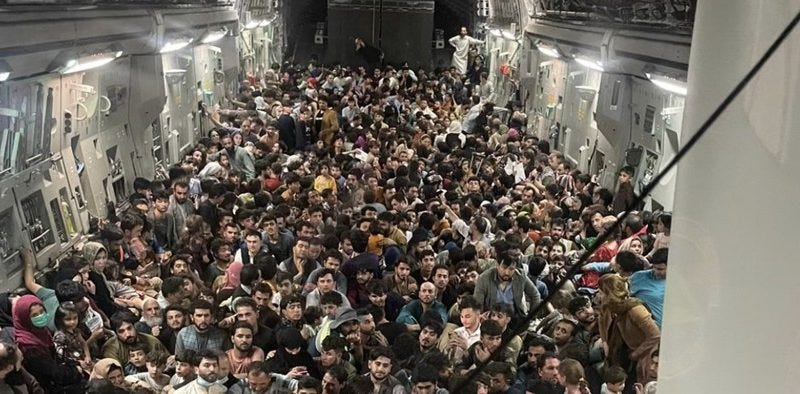Hello Friends and Greetings from Tehran,
This is the second post of this week, although I was not supposed to write the second one, but, I was following the events in Afghanistan and couldn’t detach my mind from it. I saw a painting couple of days ago and saw images from Afghanistan, especially Kabul and it was like the same pictures in different time frames.
A Ride for Liberty
In 1862, Eastman Johnson, an American painter, painted the fugitive slave family riding a horse toward the Union army. The painting is called: "A Ride for Liberty."
The painting illustrates the experience of "contraband" slaves during the war. As a means to control their own destiny, African-American men and women escaped from their owners and arrived at Union camps. In exchange for their freedom, slaves offered labor and knowledge of local environments to advance military campaigns for a then losing Union army. [...]" A Ride for Liberty demonstrates a moment during the war where slaves were instrumental in obtaining their own freedom. Thus, the painting reveals some of the social and political forces behind the Emancipation Proclamation by portraying the actions of runaway slaves that helped shape Lincoln's policy.1
The first time I saw the painting, in a blink, I felt the stress of running from a situation. Look at the head of the woman turned to back. The space is foggy. The man is looking ahead, and the kid's head is bowed; he doesn't want to look around.
This is the image of fear and hope at the same time.
The image of losing and gaining.
The image of leaving and arriving.
It's somewhere between.
It's a liminal space.
It's between past and future.
It's Not in the past, nor in the future.
The Kabul Airport Picture
The images of Kabul airport in the news and how people hanged themselves to the plains reminded me of the painting of Johnson. It seems they are similar pictures in two different time frames. Take a look at these moments and photographs.
Look at the faces. Look at the crowd. It's shocking. The pictures are the meaning of grabbing hope. Finding a way out to live again. These images represent millions of Afghans, especially women and girls afraid to face rigid limitations or even be killed. (Back to the story of the Kabul school bombing.)
The Liminal Space
There are moments in life that are the subject of transition from one situation to another. It is not the future nor the past. It's somewhere between. We all had experienced such moments when we wanted to change our current situation to another. Like, divorce, job loss or change, moving to another city or country, losing someone, etc. In such situations, we experience moments in between. It's like nowhere. We are not accomplished and not detached. It's between two worlds.
The word liminal comes from the Latin word 'limen', meaning threshold – any point or place of entering or beginning. A liminal space is a time between the 'what was' and the 'next.' It is a place of transition, a season of waiting, and not knowing.2
There are physical places as liminal spaces. Airports, for example, or parking lots, stairs, elevators. These are spaces between two situations.
Holding Space
When we are in a liminal space, we feel vulnerable, and we need a safe space to express ourselves. To grieve without the fear of being judged or observe our concerns and insecurities. We need to hold space for ourselves or getting help from someone to hold space for us.
Holding space means being physically, mentally, and emotionally present for someone. It means putting your focus on someone to support them as they feel their feelings. 3
Holding space is like a bowl that holds the water. The bowl becomes a safe space for water.
Liminal Space of Afghanistan
Back in 2003 or 2004 (I can't remember the exact year), I was a junior network administrator. At that time, I had the opportunity to become the trainer for some Afghan diplomats who came to Iran to attend courses on economics, politics, and Information Technology. My mission was to help them gain the skill of working with Microsoft Windows, Office, and the Internet.
It was after the defeat of the Taliban. All the diplomates were highly educated, but some had to leave the country during the war, and some were hardly passing days. I remember some of them who hold a Ph.D. was working as a construction worker in Iran. (Many Afghans migrated to Iran as the war begun).
In that one week, besides the training sessions, I had the opportunity to listen to their stories from the war and the hardship they experienced in life. All I remember is that those people were hopeful for the future. They had a bright vision for their country at that moment.
I was following the news about Afghanistan and remembered how motivated Vahid was one of the training participants. I am curious what has happened to him? Is he alive? Is he in Afghanistan? … ? Did he contributed to any changes in his country?
Now, millions of Afghans are in a liminal space. They are stuck somewhere in between. There's no vision for the future. I'm not talking politics, how the transition committee will work in Afghanistan, or even what Taliban strategy will be. I'm talking about millions of people who are vulnerable now.
One of my clients told me that she's trying to escape an Afghan girl who is a singer and has been deported from Iran and must go back to Kabul. She was trying to find a way to transfer her to another country.
Some Questions to Think
What do Afghanistan Pictures tells you?
What Narratives evokes in you?
Is there any chance or opportunity for you to hold space for others (even Afghans) that are in liminal space?
How should we make decisions globally and act locally to promote equity?










